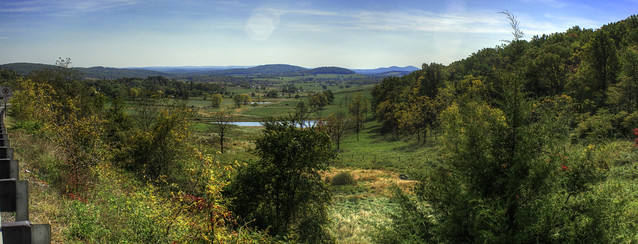Forums › Forums › Get Technical › Hardware › Panoramic head for under $20
- This topic has 8 replies, 4 voices, and was last updated 13 years, 2 months ago by
 orionid.
orionid.
-
AuthorPosts
-
October 1, 2010 at 11:55 pm #2060
 orionidParticipant
orionidParticipantWent strolling through my local Home Depot today and got inspired.

1) Acquire a 36 inch length of perforated steel angle-iron. Galvanized zinc seems to be the best balance of weight, rigidity, and price. Cut two lengths, one 4-5 inches, and one 12-18 inches depending on the physical length of your intended lens usage.
Boxes of model rocket parts not required.

2) On the longer piece, mark off 6-10 inches worth of perforations at one end. Leave at least two crossmembers at the end for rigidity.

3) Using a dremel or similar rotary cutter, remove all the cross members between your marks. Go back over the edges of your cuts with a grinding tip to remove any sharp points or burrs. A flat file or emery cloth will also work for this.

4) Align the short piece of angle-bar just forward of your slot such that the pair form a U-shape with the slot on one of the vertical (non-ovelapped) sides. Bolt in place with a pair of the largest diameter bolts that will fit. I used 3/8-16 x 1 inch, in this case. I probably could have gotten by with 3/8-16 x 1/2 inch. Tighten in place.
From here out, I will refer to the outside of the U as top (long side) and bottom (short side) and the inside of the U as inside.

5) Acquire a 1/4-20 wingtip bolt and a 1/4×1 1/4 fender washer.

6) Feed the wingtip bolt from the inside through the long slot in the top and place the fender washer over it. Acquire a 1/4 x 1 1/4 neoprene fender washer and place over the steel washer.

7) Both washers and the wingtip bolt can be held in place with a 1/4 inch E-clip.

8) Optional – Add a clothesline hook to the long end opposite the slot to hang counter weight. This will help to compensate for heavy camera/lens or a crappy tripod.

9) Affix the bottom to your favorite tripod head or quick-clip with a 1/4-20 wingnut.

10) Wingtip bolt threads into the tripod mount of your camera. Slide the camera forward or backwards as necessary to align the front optic with the center of rotation on the tripod. Note, this “poor-man’s” panoramic head will only work when rotating about the vertical axis.
With any luck, I’ll be able to get out this weekend and give it a test.
October 2, 2010 at 12:08 am #33455ravnostic
ParticipantWent strolling through my local Home Depot today
You had me at Home Depot.
Is the net benefit of this project to have the lenspiece be centered over the axis of rotation?
And I had to check that my tripod is still here; I have that exact model myself. Pretty good one, for the price.
October 2, 2010 at 12:43 am #33456 orionidParticipant
orionidParticipantIs the net benefit of this project to have the lenspiece be centered over the axis of rotation?
Correct. By centering the front lens element over the axis of rotation, you can minimize or even eliminate barrel distortion as you rotate the camera for stitched panoramas. A name-brand (there are no cheapos that I’ve found) pano head starts at $250 for a single-axis like this, and can go as high as $500 for a three-axis 360 head. Most of the one and two axis mounts gravitate to the $300 mark.
October 2, 2010 at 2:52 am #33457ravnostic
Participantorionid wrote:Correct. By centering the front lens element over the axis of rotation, you can minimize or even eliminate barrel distortion as you rotate the camera for stitched panoramas.Good to know going into Mtns, Volcanoes, and waterfalls (soon.)
October 2, 2010 at 3:39 am #33458chupathingie
ParticipantFirst:
Very cool.Second:
Curse you, MacGuyver… just when I was expecting to sit and mindlessly surf the net, you’re making me think. Now, I’ve got an ugly kludge for getting the nodal point over the z-axis on the fisheye, but the camera’s oriented sideways for that. I think a variation of what you have there would work on 2 axes for the preferred landscape lens. My head gets me close, but I still lack an inch to an inch &1/2 forward travel of getting the iris directly over the z-axis (below). The nodal point is just behind the forward grip ring.

This is fine for a single row of shots, provided nothing is close enough to show parallax, but I normally shoot multiple rows and would love to be able to get some foreground in as well. I think I’ve got some steel U-channel shelving supports laying around that might be sturdy enough…provided I can work out the details…October 2, 2010 at 3:55 am #33459 orionidParticipant
orionidParticipantI just bought a new Benro tripod with a Manfrotto 3-axis pan head (got B&H gift cards for my birthday!). Looking at the manfrotto head, as well as yours in the photo, this bracket may work for two-axis based on alignment with the various head axises. I used the cheapo tripod for simplicity sake in the photo (plus the new tripod hasn’t come it yet, just the head). I’ll have to play around with it when I get up tomorrow.
Hope your thought mill doesn’t keep you up all night ;).
February 13, 2011 at 2:12 am #33460GregScott
ParticipantI would like you to help me understand why this is necessary, please.
Thinking as an engineer, if you are shooting landscape pano, why would this be helpful? Surely any distortion from being not quite on the center of rotation is “microscopic”, a matter of inches, in relationship to hundreds of meters from your subject. Also, the actual distortion of a lens focused at infinity is essentially constant, right? Why would such a small offset be useful when stitching panoramas?Thank you.
February 13, 2011 at 3:53 am #33461chupathingie
ParticipantAnything in the foreground will suffer from parallax if the iris of the lens is not positioned on the pivot point of the mount. If you have nothing in the foreground, it’s a moot point.
February 13, 2011 at 4:02 am #33462 orionidParticipant
orionidParticipantI would like you to help me understand why this is necessary, please.
Thinking as an engineer, if you are shooting landscape pano, why would this be helpful? Surely any distortion from being not quite on the center of rotation is “microscopic”, a matter of inches, in relationship to hundreds of meters from your subject. Also, the actual distortion of a lens focused at infinity is essentially constant, right? Why would such a small offset be useful when stitching panoramas?Thank you.
It’s less for barrel distortion (although, it does seem to help with that as well. Unfortunately, the optics behind that are beyond me, so I can’t tell you why), so much as for parallax error when you have depth to the subjects in your panorama.
Example:

Untitled_Panorama1a by Orionid, on FlickrWhen you rotate about the nodal point, all of your subjects will appear to remain in the same alignment with each other, regardless of their length. When you rotate several inches behind the nodal point, ie the tripod mount on a dslr body, you move the point that the camera “sees” from, and it throws off this alignment, which then causes problems in stitching.
Try this: look at a small object on the far wall, then close one eye. Put one finger up so that it blocks your sight of that object. Turn your head to either side as you normally would, using your neck as the center of rotation. You’ll now notice a visible gap between the object and your finger. Now try it again, while trying to keep your finger covering the object, and you’ll see that you have to pull your upper body in a way that rotates your head with your eye as the center of rotation.
-
AuthorPosts
- The topic ‘Panoramic head for under $20’ is closed to new replies.